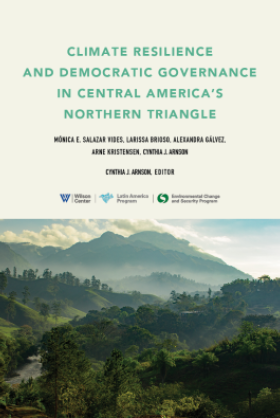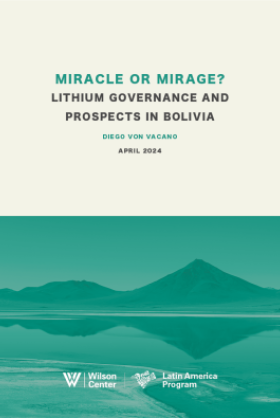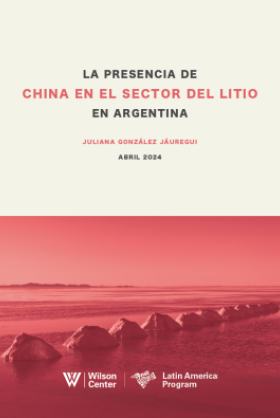Gender Equity, Health, and Cultural Tensions in the Amazon
Poverty in Latin America has become increasingly “feminized,” said John Coonrod, executive vice president of The Hunger Project, at the Wilson Center on October 22. As a result, many governments and NGOs are starting to focus on the needs of women, especially indigenous women. And yet discussions about gender equity, cultural differences, and ethnicity are still uncommon, said Brandeis University professor Cristina Espinosa.
Overview
Poverty in Latin America has become increasingly “feminized,” said John Coonrod, executive vice president of The Hunger Project, at the Wilson Center on October 22. As a result, many governments and NGOs are starting to focus on the needs of women, especially indigenous women.
And yet discussions about gender equity, cultural differences, and ethnicity are still uncommon, said Brandeis University professor Cristina Espinosa. “This is important because development interventions, in general, and health interventions, in particular, don’t occur in a vacuum, they occur in the context of power asymmetries, cultural differences, and gender subordination.”
Women Caught Between Tradition and Modernity
From the Peruvian Amazon to the cities of Brazil, many Latin American women are in the midst of an uncomfortable dance between modernity and tradition.
Patriarchal norms push women towards roles as mothers and caretakers, but economic growth and globalization are presenting new options.
With poverty rates declining from 48.4 percent to 31.4 percent between 1990 and 2010 and GDP per capita at $11,858 for Latin America and the Caribbean, the region has made great progress.
Along with this development, women are gaining more power, both within the family and on the national level, as more women enter the labor market and handle household funds through conditional cash transfer programs. Women are also acting as temporary heads of household, said Coonrod, as men from rural areas go off to mines or in search of cash employment in cities.
And yet, gross inequalities – from education to income – persist, especially among indigenous women, who face challenges balancing their aspirations for better rights and services as women with broader indigenous rights efforts, said Coonrod.
While indigenous people make up only 10 percent of the region’s population, in frontier areas and countries like Peru and Bolivia, the ratio is much higher (48 percent and 62 percent, respectively).
Negotiating Identities
One of the sectors newly empowered women are trying to change is healthcare.
Modern health interventions have reached the Amazon and present new challenges and opportunities for communities and health workers alike. When health programs come to remote villages, local inhabitants are eager for assistance. However, different cultural frameworks and local power asymmetries affect the outcome of interventions. For example, women may hesitate to ask for the medicines they really need or not use them correctly because of cultural traditions that inhibit them from doing so, Espinosa said.
Often times in designing development or health interventions, “gender came as an afterthought,” Espinosa said. But “men and women have a different way to negotiate their identities.”
The habit of labeling indigenous cultural norms as ignorant has also created a social stigma around modern health interventions.
“Ethnicity and gender interface and affect health interventions in very specific ways,” said Espinosa, like in the case ethnic taboos. For example, indigenous women are often afraid to disclose their status as “impure” (meaning pregnant, menstruating, or recently sexually active), which according to indigenous custom means they are not allowed to administer medicine, for fear of being ridiculed by health workers.
In this way, they are further marginalized in a situation where they are already the most marginalized group. The hegemonic “modern” cultural framework “doesn’t recognize that there are others,” elaborated Espinosa. “Indigenous views are really disregarded.”
A one-size-fits-all approach to health work in indigenous communities will not work, she continued, gender and cultural sensitivities must be addressed.
Participatory Approaches to Health and Empowerment
In the communities in which they work, Coonrod said, The Hunger Project tries to empower indigenous women and ultimately relies on them to be “change agents.”
They give them tools for social organization and political mobilization, he said, and encourage them to speak up about gender inequality through community workshops and dialogues. Authentic partnerships with grassroots local governments can help induce change at the national and international levels. However, “where these issues of livelihood and health have to get worked out is at the local level, and so strengthening participatory local democracy is key,” said Coonrod.
In cities, however, the strategy is different. Juliana Martinez-Franzoni, associate professor at the University of Costa Rica, believes that technocrats and policymakers can be the most effective advocates for gender equity through initiatives like national conditional cash transfer programs.
Though originally designed to alleviate poverty by providing families with food vouchers or payments in exchange for enrolling children in school and getting health check-ups, conditional cash transfer programs like Bolsa Familia in Brazil and Oportunidades in Mexico put mothers in a position of power since the money often flows through them.
Some suggest that these programs can encourage gender equity even more by making changes that specifically promote paid work for women outside the household, expand child care services, and increase the role of men in performing domestic chores, said Martinez-Franzoni.
Others argue that conditional cash transfers in their current form are already successful in empowering women economically “precisely because the state is finally acknowledging the central role of women as mothers,” she said. For these supporters, moving the concept of maternalism from the private to the public realm is enough of a positive thing.
“There is a political climate that could easily have positive effects in dimensions of gender equity,” suggested Martinez-Franzoni. But there is still widespread opposition to promoting gender equity through these types of social programs.
Franzoni said that in order to take advantage of this opportunity, there is a need to “re-socialize” some technocrats and public policymakers “who are reinforcing the notions that poor women don’t know anything,” rather than seeing them as partners in the movement for equitable development.
Supporting Their Voices
As female-headed households flourish in the remotest parts of Bolivia and Peru, and in urban landscapes from Chile to Brazil, women need tools and resources to empower themselves, said Coonrod.
“The strongest advocates for indigenous women are other indigenous women,” he said.
Though continued discussion about these gender issues is welcome, Martinez-Franzoni thinks that instead of trying to continually convince communities and politicians of the need for gender equity, Latin Americans should recognize the fact that poor and marginalized women across the region are already demanding equity and fairness.
The allies of gender equity – locally and internationally – already exist, and those people need to be empowered instead of attempting to change everyone’s minds, she argued.
Event Resources:
Drafted by Payal Chandiramani, edited by Schuyler Null
Speakers
Hosted By

Environmental Change and Security Program
The Environmental Change and Security Program (ECSP) explores the connections between environmental change, health, and population dynamics and their links to conflict, human insecurity, and foreign policy. Read more

Global Risk and Resilience Program
The Global Risk and Resilience Program (GRRP) seeks to support the development of inclusive, resilient networks in local communities facing global change. By providing a platform for sharing lessons, mapping knowledge, and linking people and ideas, GRRP and its affiliated programs empower policymakers, practitioners, and community members to participate in the global dialogue on sustainability and resilience. Empowered communities are better able to develop flexible, diverse, and equitable networks of resilience that can improve their health, preserve their natural resources, and build peace between people in a changing world. Read more
Thank you for your interest in this event. Please send any feedback or questions to our Events staff.








